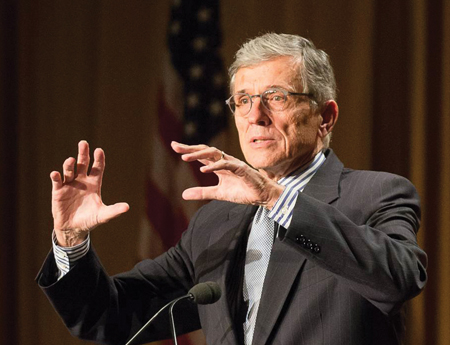FCC Circulates Item Making Linear OVDs MVPDs

Related: Aereo Applauds FCC OTT Definitional Move
The FCC has circulated a Media Bureau proposal to make linear over-the-top providers MVPDs. FCC chairman Tom Wheeler blogged the news Tuesday (Oct. 28), saying it was about insuring access to programming by Internet video services, including the ability to negotiate for retransmission consent, similar to the way the FCC opened up cable programming to satellite competitors in the 1990s.
"Consumers have long complained about how their cable service forces them to buy channels they never watch," Wheeler said. "The move of video onto the Internet can do something about that frustration – but first Internet video services need access to the programs. Today the FCC takes the first step to open access to cable programs as well as local television."
An FCC spokesperson described it as an effort to make the definition of MVPD "technologically neutral" and something that will "update the FCC’s video competition rules to encourage over-the-top innovation and consumer choice."
The existence of the NPRM was first reported by B&C/Multichannel News.
It is unclear what obligations—PEG channels, program exclusivity rules, for example—will go along with linear OTTs new status, assuming the chairman gets three votes for the move.
“There are a number of obligations that apply to MVPDs either by statute or by FCC rules, and the NPRM asks how these obligations should apply to Internet-based distributors of video programming,” said an FCC source.
The smarter way to stay on top of broadcasting and cable industry. Sign up below
Wheeler also suggested an unbundling angle to the proposal as he pushed the move as a way to promote his mantra of "competition, competition, competition."
"In 1992 Congress realized that the then-nascent satellite industry would have a hard time competing because much cable programming was owned by cable companies who frequently kept it from competitors," he said. "Congress mandated access to cable channels for satellite services, and competition flourished. Today I am proposing to extend the same concept to the providers of linear, Internet-based services; to encourage new video alternatives by opening up access to content previously locked on cable channels. What could these over-the-top video providers (OTTs) supply to consumers? Many different kinds of multichannel video packages designed for different tastes and preferences. A better ability for a consumer to order the channels he or she wants to watch."
Wheeler cited CBS and Sony's online plays as among the new services that need access to content.
"So-called linear channels, which offer the viewer a prescheduled lineup of programs, have been the largely exclusive purview of over-the-air broadcasting, cable, and satellite TV," he said. "But these kinds of packages of programming are coming to the Web as well. Dish has said that it intends to launch an online service that may include smaller programming bundles. And it has already begun offering foreign language channels online. Sony, DirecTV, and Verizon are also in the hunt. Recently, CBS announced a streaming service that includes linear channels, separate from cable subscriptions; and the new HBO service may as well."
The FCC had tentatively concluded that to be a multichannel video provider, a distributor had to own the facilities, but Wheeler suggested that should change. "[T]he definition of an MVPD should turn on the services that a provider offers, not on how those services reach viewers," he wrote. "Twenty-first century consumers shouldn’t be shackled to rules that only recognize 20th century technology."
The NPRM would reverse a tentative, bureau-level conclusion in the Sky Angel program-access complaint that having a facilities-based transmission path was necessary to be an MVPD. The FCC tentatively concluded that an MVPD has to have control of both the content and the transmission path—copper, fiber, satellite signals to be delivering a channel—and that an OVD distributor lacks that path since it does not control a facilities-based channel to deliver it.
The FCC signaled in the Comcast/NBCU deal that it expected over-the-top video to become a competitor to traditional MVPDs going forward and, therefore, included conditions requiring the company to make its programming available to OTT providers on nondiscriminatory terms and conditions.
The National Cable & Telecommunications Association has argued that a transmission path is necessary to be an MVPD.
It told the FCC in comments on Sky Angel that the 1992 Cable Act was clearly intended to promote "facilities-based MVPD competitors," which would require facilities.
To define it otherwise, they say, would result in "expansive regulation of the Internet" and conferring rights and obligations on online entities the FCC does not track or license, may not have physical facilities in the U.S. and which "were never intended to be the subjects of such regulations."
Contributing editor John Eggerton has been an editor and/or writer on media regulation, legislation and policy for over four decades, including covering the FCC, FTC, Congress, the major media trade associations, and the federal courts. In addition to Multichannel News and Broadcasting + Cable, his work has appeared in Radio World, TV Technology, TV Fax, This Week in Consumer Electronics, Variety and the Encyclopedia Britannica.

